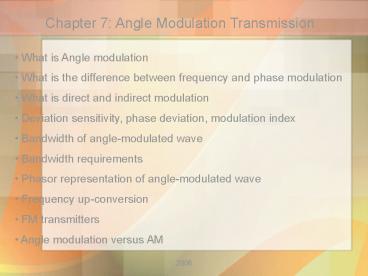Chapter 7: Angle Modulation Transmission - PowerPoint PPT Presentation
1 / 36
Title:
Chapter 7: Angle Modulation Transmission
Description:
What is the difference between frequency and phase modulation. What is direct and indirect modulation. Deviation ... Frequency up-conversion heterodyne method ... – PowerPoint PPT presentation
Number of Views:1327
Avg rating:3.0/5.0
Title: Chapter 7: Angle Modulation Transmission
1
Chapter 7 Angle Modulation Transmission
- What is Angle modulation
- What is the difference between frequency and
phase modulation - What is direct and indirect modulation
- Deviation sensitivity, phase deviation,
modulation index - Bandwidth of angle-modulated wave
- Bandwidth requirements
- Phasor representation of angle-modulated wave
- Frequency up-conversion
- FM transmitters
- Angle modulation versus AM
2
Angle modulation
?inst(t) instantaneous phase (radians) Questio
n What is the instantaneous frequency?
3
Angle modulation
vanglemod (t) angle modulated wave (Volt) Vc
peak carrier amplitude (Volt) ?inst
instantaneous angular frequency (rad/sec) ?inst
instantaneous phase (radians)
4
Phase modulation
The instantaneous phase of a harmonic carrier
signal is varied in such a way that the
instantaneous phase deviation i.e. the difference
between the instantaneous phase and that of the
carrier signal is linearly related to the size of
the modulating signal at a given instant of time.
5
Phase modulation
The instantaneous phase of a harmonic carrier
signal is varied in such a way that the
instantaneous phase deviation i.e. the difference
between the instantaneous phase and that of the
carrier signal is linearly related to the size of
the modulating signal at a given instant of time.
Kp is the phase deviation sensitivity (rad/Volt)
6
Frequency modulation
The frequency of a harmonic carrier signal is
varied in such a way that the instantaneous
frequency deviation i.e. the difference between
the instantaneous frequency and the carrier
frequency is linearly related to the size of the
modulating signal at a given instant of time.
7
Frequency modulation
The frequency of a harmonic carrier signal is
varied in such a way that the instantaneous
frequency deviation i.e. the difference between
the instantaneous frequency and the carrier
frequency is linearly related to the size of the
modulating signal at a given instant of time.
Kf is the frequency deviation sensitivity
8
PM
Kp is the deviation sensitivity
FM
Kf is the deviation sensitivity
TASK Make block diagrams of PM and FM modulators
9
PM
Kp is the deviation sensitivity
Phase modulator
Modulating signal source
PM wave
Direct
Modulating signal source
Differentiator
Frequency modulator
PM wave
Indirect
10
FM
Kf is the deviation sensitivity
Modulating signal source
Frequency modulator
Direct
FM wave
Integrator
Phase modulator
Modulating signal source
FM wave
Indirect
11
Frequency modulation of single frequency signal
PM
FM
12
PM and FM of sine-wave signal
Carrier
Modulating signal
?
?
13
PM and FM of sine-wave signal
Carrier
Modulating signal
FM
PM
14
Phase Deviation and Modulation Index
m is the peak phase deviation or modulation index
PM
(radians)
FM
(unitless)
15
Frequency Deviation
FM
FM
PM
(peak) frequency deviation
dependent of the frequency
PM
(peak) frequency deviation
independent of the frequency
16
PM and FM of sine-wave signal
17
Bessel function of the first kind
m is the modulation index
FM
PM
is the Bessel function of the first kind
18
Relation AM and angle mod
19
Bessel function of the first kind
20
Bandwidth requirements of Angle-mod waves
1 Low-index modulation (narrowband FM)
m lt 1 ( fm gtgtgt ?f )
(Hz)
2 High-index modulation (wideband FM)
m gt 10 (?f gtgtgt fm )
3 Actual bandwidth (look at Bessel table page 266)
where n is the number of significant sidebands
4 Carsons rule (approx 98 of power)
21
Example
FM modulator ?f 10 kHz fm 10 kHz Vc 10
V fc 500 kHz
Draw the spectrum? What is the bandwidth using
Bessel table? What is the bandwidth using
Carsons rule?
22
Example
?f 10 kHz fm 10 kHz Vc 10 V fc 500 kHz
m 1
Fig 7-7
23
Phasor representation of Angle-mod wave
m lt 1 (narrowband FM)
Fig 7-9
24
Phasor representation of Angle-mod wave
m gtgt 1 (Wideband FM)
Fig 7-10
25
Average Power of Angle-mod wave
Instantaneous power in unmodulated carrier is
(W)
Pc carrier power (Watts) Vc peak unmodulated
carrier voltage (volts) R load resistance (ohms)
Instantaneous power in angle-mod carrier is
So the average power of the angle-mod carrier is
equal to the unmodulated carrier
26
Frequency and Phase modulators Direct FM Modulator
Fig 7-16
27
Linear integrated-circuit direct FM modulator
High-frequency deviations and high modulation
indices.
Fig 7-20
28
Frequency up-conversion heterodyne method
With FM and PM modulators, the carrier at the
output is generally somewhat lower than the
desired frequency of transmission
Fig 7-24 a
29
Frequency up-conversion multiplication
Fig 7-24
30
Indirect FM Transmitter
Fig 7-27
31
Indirect FM Transmitter
m lt 1
Fig 7-28
Problem !!!!!!
32
Indirect FM Transmitter
m lt 1
Fig 7-28
?max 1.67 miliradiance
Aim ?f 75 kHz and ft 90 MHz
33
Armstrong Indirect FM Transmitter
Where are the frequency conversions ?
Fig 7-27
34
Angle mod versus AM
- Advantages of Angle modulation
- Noise immunity
- Noise performance and signal-to-noise
improvement - Capture effect
- Power utilization and efficiency
- Disadvantages of Angle modulation
- Bandwidth
- Circuit complexity and costs
35
End Lecture 7
36
Summary and Outlook
g
Next lecture Chapter 8 Angle modulation
reception

